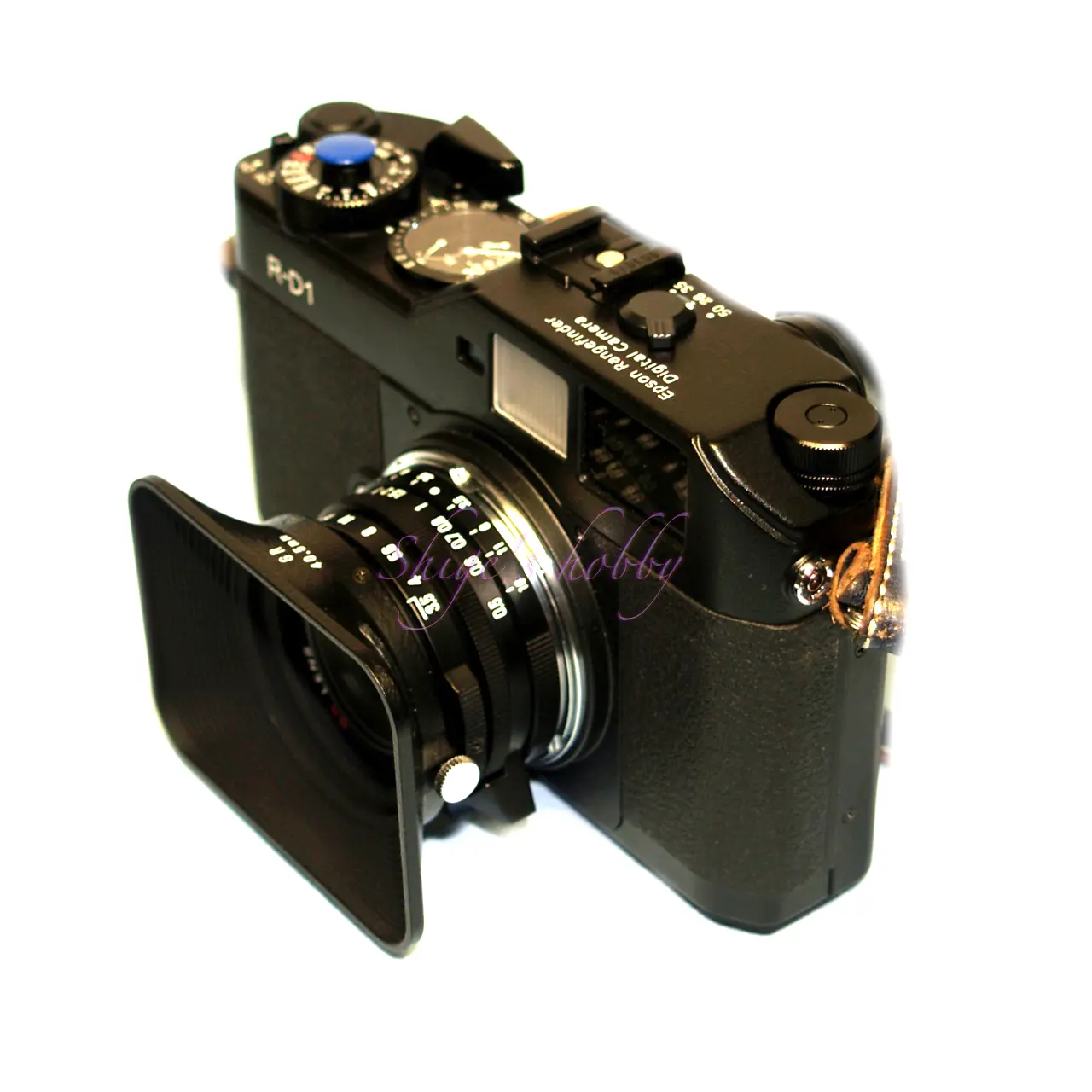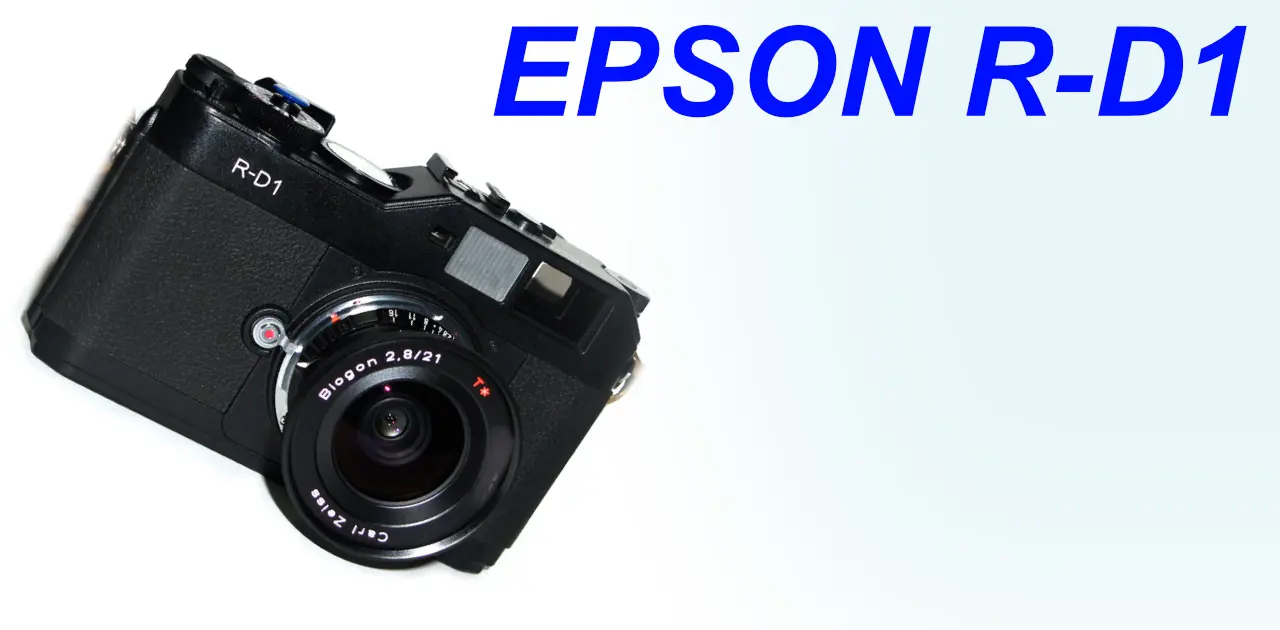Last updated on 2025-10-26
A review and photo examples of the Epson R-D1 rangefinder digital camera.
Table of contents
Gallery
- The lenses used in the example photos are as follows:
- HOLOGON 16mm(Ms-optics)
- Voigtlander Color Skopar L 35mm F2.5C
- Rollei Sonnar 40mm
- CONTAREX BIOGON 21mm
- BIOGON ZM 35mm
- Voigtlander COLOR SKOPAR 21mm
- AVENON 28mm
Review


1.Overview
The R-D1 was released in 2004, two years before the Leica M8, by Epson. It was the first Leica M-mount compatible digital rangefinder camera with a 6-megapixel APS-C sensor.
The R-D1 is equipped with a clock-like analog meter and a rotating LCD panel, making it a fun camera in contrast to the practicality of the later LEICA M8.
Although the sensor is APS-C, I think it is a very high level of technology to have the digital part housed in the mechanism of a film camera BESSA without making the camera too large.
The raw format of this camera is Epson’s original ERF format, which produces 3008 x 2000 pixel images from the 6-megapixel sensor. The capacity is 10MB per image, so if you use a 2GB SD card, you can take about 200 images.
The battery is a small EPALB1 (NP-80, Fujifilm, DB-20, Ricoh). Although it is small, it has enough capacity to drive this camera, and although it is a camera that cannot take continuous shots, I was able to take 200 pictures on a 2GB SD card and the battery never ran out. According to the information on the Epson official website, it is said that it can take 1,000 pictures in shooting condition 1 and 360 pictures in shooting condition 2.
Epson also provides software for developing image data free of charge, and EPSON Photolier is still officially distributed as of 2024. This software is only released for Windows, but it is quite easy to use, and when I was an R-D1 user, I developed the images I took with Photolier.
For photographers who started using cameras in the 2020s, Epson is probably more widely recognized as a printer manufacturer.
However, in the 2000s, Epson manufactured and sold not only image output devices but also compact digital cameras for image input, and the R-D1 was an extension of that.
2.Usage
The R-D1 is equipped with an early 6-megapixel APS-C size sensor, and this sensor and Epson’s image processing were able to produce images that directly expressed the characteristics of various L39 and M-mount lenses. This makes you realize that the number of pixels in a camera is not everything.
The R-D1’s image creation was designed to make the low-pass filter as thin as possible in order to realize the concept of making the most of the lens’s characteristics. This focus on low-pass filters led to several manufacturers, including Leica, Sony, Pentax, and Ricoh, releasing cameras without low-pass filters, and the improvement in resolution of captured images became widely recognized. The R-D1 had an advanced design for 2004.
The camera’s mechanical parts, such as the viewfinder and shutter, seem to use Cosina technology, and you can see traces of BESSA in various places. The maximum shutter speed is 1/2000, the same as the BESSA series, and it can be used to a certain extent with bright lenses with small F-numbers.
The shutter speed adjustment dial is excellent, and the shutter speed is located beyond the +- scale for increasing or decreasing sensitivity in the AE mode of automatic exposure, and the functions are all integrated into one dial. Furthermore, the ISO sensitivity setting is also integrated here.
The shutter sound, which gives the feeling that you are using a camera, is high-pitched and sounds like the metal of the metal curtain vertical focal plane shutter interfering with the shutter. It was not a quiet camera.
The Leica M8 and M9 M digital cameras released by Leica had relatively loud shutter sounds, but the M typ240 and up became quieter and quieter.
APS-C size sensors cannot use the focal length of a 35mm lens as it is, but with lenses such as wide-angle lenses where the amount of light in the peripheral areas drops and image quality deteriorates, it has the advantage of being able to use only the good image quality in the center, although it means giving up some of the lens’ individuality.
Even with the HOLOGON 16mm, the highest peak of special lenses, there is vignetting, but there is no color cast around the edges of the image, which is a problem with the LEICA M9, so it can be used as a 24mm wide-angle lens.
The manufacturer does not recommend the use of lenses with a rear lens inside the camera, such as the HOLOGON, so as a rule, use is at your own risk.
In addition, the camera is very thin and light, taking advantage of the fact that it does not have a mirror box, and it matches well with the small Cosina Voigtlander Color Skopar lenses rather than large lenses with large apertures.
This R-D1 is the camera that got me hooked on rangefinder cameras, and I used it for three years from 2005 to 2007, while the manufacturer adjusted the vertical misalignment of the viewfinder, which is a problem with this camera, several times, before moving on to the LEICA M8.
As the 2020s begin, there are fewer used R-D1s in working order, and they are rarely seen on the market, and even if you do see one, it is quite expensive, so I probably won’t use it again.
3.Summary
To conclude, the Epson R-D1 can be described as a camera that was ahead of its time.
As an introduction to Leica, it was an excellent camera.
As I will continue later, it is a great shame that a successor, the R-D2, was never released.
Unreleased successor camra R-D2
What’s unfortunate about this camera is that it only underwent minor changes, and the second-generation R-D2 was never released. It’s easy to imagine that it would have been difficult for Epson, whose main business is not the camera body, to continue the business as the costs of developing and manufacturing digital cameras increased.
For example, if Sony, a direct descendant of Konica Minolta, which made rangefinder film cameras, had taken over this model, it would have been possible to create a rangefinder digital camera with its own sensor and image processing technology that only Sony could have.
However, since this camera uses a lot of Cosina’s technology in the camera part, if the rights were to be transferred to another company, there may have been an issue as to what to do with Cosina’s rights and technology.
If Cosina had continued to make it themselves, there would have been problems with software development, and since Cosina stopped making the BESSA film camera series after the release of this camera, there may have been problems with the design of the rangefinder camera’s mechanical parts and the supply of parts. It seems that it would have been difficult to continue either way, but it is very unfortunate that a successor to this rare camera was not released.
In 2017, the French company Pixii released an M-mount compatible rangefinder digital camera. Like the R-D1, Pixii started with an APS-C size sensor, and in 2024 released the Pixii Max equipped with a 35mm full-size sensor.
Although digital camera technology has become relatively versatile due to improvements in the technical capabilities of outsourced manufacturers, I think it is amazing that they continue to plan, design, and sell this product. Since there is no distributor in Japan and it is quite expensive in euros, I don’t have much chance to use it, but it is one of the cameras I would like to try someday.
Specification and Competitors
In 2006, the R-D1s, a minor change model, was released.
- A special feature of the R-D1s is that a heat sink has been added to the CCD to reduce sensor noise.
- The original R-D1 did not have this heat sink, but I have never found it to be an inconvenience in practice.
- Also, when using the R-D1x, I did not notice a significant difference in the way noise is handled compared to the R-D1.
- The results may be different if the CCD heats up from continuous shooting, but I did not use it in that way.
In 2009, the R-D1x, a minor change model, was released.
- The rear LCD screen has been enlarged to 2.5 inches.
- The LCD resolution remains the same, but the feature that allowed the LCD display to be rotated and hidden, which was available on the previous two models, has been discontinued. As a result, the LCD display is fixed and is always visible.
- A special grip is now included, but the shooting specifications have not changed from the R-D1.
| Items | R-D1 | R-D1s | R-D1x |
| Effective pixels(Megapixels) | 6.1-Megapixcels | 6.1-Megapixcels | 6.1-Megapixcels |
| Sensor manufacturer and model number | Unknown | Unknown | Unknown |
| Sensor size | APS-C 23.7 x 15.6mm | APS-C 23.7 x 15.6mm | APS-C 23.7 x 15.6mm |
| Rear LCD | 2.0 inch 23.5 million dot | 2.0 inch 23.5 million dot | 2.5 inch 23 million dot |
| Viewfinder Magnification | 1 | 1 | 1 |
| Mechanical Shutter speed | 1/2000 | 1/2000 | 1/2000 |
| Battery | EPALB1 | EPALB1 | EPALB1 |
| Recorded Media | SD | SD | SD,SDHC |
| Size(mm) W x H x D | 142.0 x 88.5 x 39.5 | 142.0 x 88.5 x 39.5 | 142.0 x 88.5 x 39.5 |
| Weight (g) (without battery) | 570 | 570 | 570 |
| Release date | 2004 | 2006 | 2009 |
| Body color | Black | Black | Black |
Lens
| Focal length | Lens name | 35mm equivalent focal length |
| 12mm | Ultra Wide Heliar 12mm | 18mm |
| 15mm | Super Wide Heliar 15mm | 22.5mm |
| 21mm | Color Skopar 21mm | 31.5mm |
| 25mm | Snap Shot Skopar 25mm | 37.5mm |
| 28mm | Color Skopar 28mm | 42mm |
| 35mm | Color Skopar 35mm | 52.5mm |
| 40mm | Nokton 40mm | 60mm |
| 50mm | Nokton 50mm | 75mm |
| 75mm | Color Heliar 75mm | 102.5mm |
| 90mm | Apo Lanthar 90mm | 135mm |
Options
- Dedicated battery:EPALB1
- Genuine leather case:RD1SC1
Reference links
Update history
- 2025.4.16
- 2024.9.11
- 2024.07.12
- 2024.02.17
- 2023.12.19
Affiliate Link
- Please see the disclaimer regarding advertising here.
- Italicized links in the text are advertisement links that take you to other sites.

Amazon Prime Sale



Be First to Comment